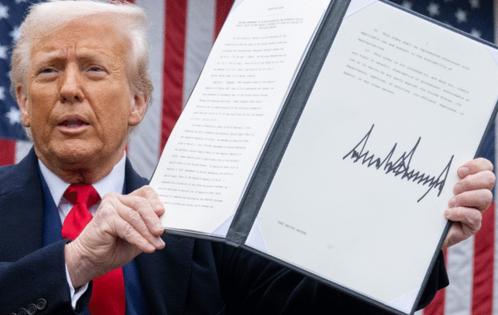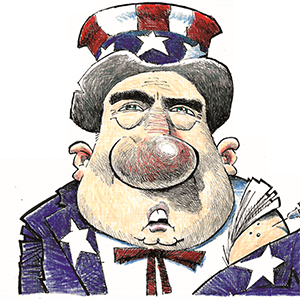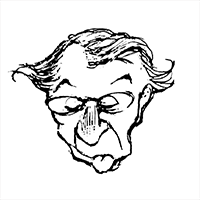Trump's 35% tariff threat feeds Japan's worst-case scenario fear
Published in News & Features
U.S. President Donald Trump threatened Japan with tariffs of up to 35% as he ramped up tensions for a third straight day, fueling fears of a worst-case scenario among market players and raising doubts over Tokyo’s tactics in trade talks.
Japan should be forced to “pay 30%, 35% or whatever the number is that we determine, because we also have a very big trade deficit with Japan,” Trump said, again flagging the possibility that across-the-board tariffs could go much higher than the 24% initially penciled in for July 9. “I’m not sure we’re going to make a deal. I doubt it with Japan, they’re very tough. You have to understand, they’re very spoiled.”
Market participants and analysts warned against taking Trump’s comments at face value and suggested that some kind of deal will eventually get done. But they also warned that Prime Minister Shigeru Ishiba’s government may need to change tack from a friendly and firm stance that is now leading the two sides to brinkmanship.
“There is some risk of a U.S. tantrum that results in higher punitive actions by Washington this month,” said Kurt Tong, a former senior U.S. diplomat in Asia who’s now a managing partner at the Asia Group. “If that happens, Japan may have no choice but to hit back with its own specific countermeasures.”
Trump’s latest threat fits in with a high-pressure deal-making strategy that sometimes results in big last-minute concessions on both sides, as seen with China, but market players still need to game out how to position themselves should talks founder.
While few analysts see Japan’s stocks collapsing on a no-deal scenario, some of them forecast the Nikkei 225 to fall into the 38,000 range, a decline of more than 4%, rather than rallying above 40,000 if there’s an agreement.
The Nikkei 225 edged down 0.6% to close at 39,762 on Wednesday while the yen was trading at 143.88 against the dollar, down around 0.3%.
Japan has so far stood firm in negotiations over across-the-board reciprocal tariffs, insisting that they be removed along with additional sectoral tariffs on autos, steel and aluminum. The car duties are particularly painful for Japan as the industry contributes the equivalent of almost 10% of gross domestic product and employs around 8% of the workforce.
Tokyo has insisted that a “win-win” deal must encompass all the tariffs in one go with Ishiba preferring no deal to a bad deal ahead of a July 20 upper house election. The prime minister on Wednesday reiterated his view that focusing on jobs and investment in the U.S. was the way forward, just like it was for Nippon Steel as it patiently sought to change Trump’s view and take over U.S. Steel.
“Japan is the biggest global investor in the U.S. and the world’s biggest contributor to U.S. jobs,” Ishiba said in Tokyo on Wednesday. “That means Japan is different from other countries.”
But as July 9 gets closer, some observers say more needs to be done to convince the U.S. to back off.
“We have to work on Trump himself, to first try to avoid the tariffs to be imposed from July 9,” said Ichiro Fujisaki, former Japanese ambassador to the U.S., adding that the president’s remarks show that Tokyo hasn’t brought enough to the table yet.
“We don’t have something like rare earths but the U.S. is dependent on Japanese industry as well. About half of materials for making semiconductors come from Japanese industry,” Fujisaki said, pointing to a possible area of leverage, too.
In the meantime, market players are evaluating the potential scale of the fallout.
“There is a lot more risk of things falling apart than is being priced in by the market,” said Zuhair Khan, a fund manager at UBP Investments. “There is always the risk of a policy blunder by either side.”
He points to the 32,000 Nikkei level on the day Trump first announced the reciprocal tariffs. “If the probability of a no deal is 25% then the Nikkei should be at 38,000.”
The point of imposing a deadline in negotiations is to create an opportunity for leverage, so it’s not surprising to see Trump pushing high tariffs as a threat to push for better deals as the date approaches, said Phillip Wool, head of portfolio management at Rayliant Global Advisors Ltd.
“There’s also an element of political theater here, as Trump’s narrative to American voters is that the US has been bullied on trade for so long, and there’s clearly a desire to look ‘tough’ on trade,” Wool said. “But there has to be a face-saving deal at some point so that it looks like the negotiation was truly a success as opposed to the mutually assured destruction of impasse and perpetually high tariffs.”
Like some other market players, Wool is wary of an overly pessimistic knee-jerk response to each remark Trump makes. If there is a big selloff in a worst-case scenario, Wool sees it as a great buying opportunity for long-term, active investors.
Strategists are split on how a bad scenario might play out for the yen. While some such as SBI Liquidity Market Co.’s Marito Ueda see the possibility of risk aversion sparking a strengthening of Japan’s currency to the 138 range against the dollar, others see a weakening as more likely.
A stalemate in trade talks would likely delay the Bank of Japan’s next interest rate hike, especially if it led to tariffs of up to 35% in the meantime, said Akira Moroga, chief market strategist at Aozora Bank. Movement would slow after the 145 mark, making a push past 147 difficult, he said.
Still, the consensus is that a deal will be reached sooner or later, and that Japan will have to concede more ground to achieve it.
“If it’s concluded I don’t think it’s going to be a win-win situation,” said Fujisaki. “Maybe a capital-letter ‘WIN’ for US, but a small letter ‘win’ for Japan.”
What Bloomberg economics says...
“If Japan is ultimately forced to pay reciprocal tariffs at those rates, on top of the 24% rate announced on ‘Liberation Day’ — currently suspended at 10% — the macroeconomic fallout would be sizable. Our estimate through a model of global trade suggests a medium-term GDP hit of around 1.2%, roughly double the 0.6% drag expected under the current levy.”
— Taro Kimura, economist
----------
—With assistance from Akemi Terukina, Momoka Yokoyama, Toshiro Hasegawa, Umesh Desai, Hidenori Yamanaka, Mari Kiyohara and Aya Wagatsuma.
©2025 Bloomberg L.P. Visit bloomberg.com. Distributed by Tribune Content Agency, LLC.







Comments